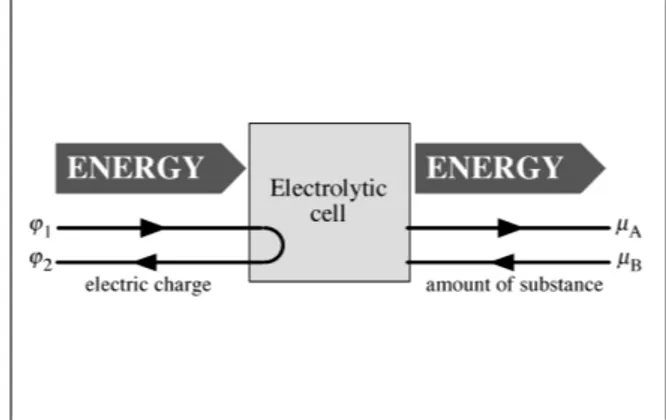CHEMICAL POTENTIAL – A QUANTITY IN SEARCH OF RECOGNITION
Measuring the Chemical Potential with an Electrochemical Cell
J. Rosenberga, F. Herrmannb
aMIT, Cambridge, United States
bUniversity of Karlsruhe, Karlsruhe, Germany e-mail: jrose@alum.mit.edu
Keywords: Chemical Potential, Fuel cell, Education
How can the values of the chemical potential be determined? In order to keep the explana- tions concrete let us consider a fuel cell. The general significance of the arguments will be seen at the end.
Fig. 1 shows the cell symbolically: A flow of chemical energy, or power Pchem = (µA – µB) · Jξ
is entering the cell from the left and an electric energy flow Pel = (ϕ1– ϕ2) · JQ
is leaving it toward the right.
Here, µA is the total chemical potential of the reactants and µB the total chemical potential of the reaction products. Jξ is the reaction rate, i.e. the reaction extent per time and JQ is the electric current, i.e. the charge flow per time.
Since the fuel cell works reversibly, the entering chemical energy flow must be equal to the outgoing electrical energy flow:
(µA – µB) · Jξ = (ϕ1– ϕ2) · JQ. (1)
This equation has a suggestive form: The reactants enter the fuel cell at a high chemical po- tential µA. They then transform into other substances with a lower chemical potential µB. Thereby, they “lift” the electric charge from the lower electric potential ϕ2 to the higher poten- tial ϕ1. Thus, the decline or drop of the chemical potential is used to lift or raise the electric charge to a higher electric potential.
The cell could also be used in the opposite way: electric energy at the entrance and
Fig. 1. Flow chart of the fuel cell. While amount of substance goes from high to low chemical poten- tial, electric charge is lifted from low to high elec- tric potential.
Fig. 2. Flow chart of the electrolytic cell cell. While electric charge goes from high to low electric potential, amount of substance is lifted from low to high chemical potential.
chemical energy at the exit, Fig. 2. Electric charge is going from high to low electric potential, thereby lifting substances from low to high chemical potential. Let us mention that this kind of device has several analogs. In an electric water pump, electric charge goes from high to low electric potential and water goes from low to high pressure. The opposite happens in a hydroelectric power plant: water goes from high to low pressure and raises electric charge from low to high potential. And yet another example: in a thermal power plant, entropy goes from high to low temperature (high to low “thermal potential”), thereby raising electric charge from low to high electric potential. The opposite is an electric heat pump, where electric charge goes down and entropy goes up.
Back to the measurement of the chemical potential.
With Eq. (1), we have a means to measure differences of chemical potentials:
The method is as follows: Measure the electric energy flow (or power) Pel = (ϕ1– ϕ2) · JQand divide by the reaction rate Jξ [1]. Actually, the procedure is even more simple. The electric current and the reaction rate are related:
JQ= z · F · Jξ
Here, z is a small integer, whose value depends on the considered reaction, and F is the Fa- raday constant. We get:
µA – µB = z · F · (ϕ1– ϕ2).
Thus, the chemical potential difference can directly be calculated from the open-circuit voltage of the corresponding electro-chemical cell.
As an example, let us consider the hydrogen fuel cell. The net reaction is 2H2 + O2 → 2H2O.
Since the hydrogen is ionized, for each 2 moles of hydrogen we have 4 moles of electrons:
2H2 → 4H+ + 4e–
and thus z = 4. We give a simple explanation of how the fuel cell works by introducing a wire as an electron conductor and ion insulator, and an electrolyte as the inverse: an ion conductor and electron insulator.
The observed electric potential difference is 1.23 V. With F = 9.65 · 104 C/mol, we get:
µA – µB = 2µ(H2) + µ(O2) – 2µ(H2O) = z · F · (ϕ2– ϕ1)
= 4 · 9.65 · 104 C/mol · 1.23 V = 474.8 kG.
Since the chemical potentials of H2 and of O2 are zero by definition, the chemical potential of water turns out to be:
µ(H2O) = –237 kG.
In principle, every chemical reaction can be run reversibly and electrochemically. Starting from the chemical elements, whose potential values are arbitrarily chosen to be zero for norm conditions, in principle the potential of any other substance can be measured.
Actually, the practical measurement of chemical potentials is not necessarily done in this way. When we need a practical way to measure some quantity, in general we do not go back to the definition of this quantity. What we do is to look for a way which is technically simple and inexpensive. For a measurement of the quantity X, any effect which depends on the values of X is applicable. In general, we do not measure a temperature by directly using the thermo- dynamic definition of the temperature. Instead we use thermocouples, resistance thermome- ters or mercury thermometers. The same holds true for the measurement of chemical poten- tials. Here, the number of possible effects that are appropriate for a measurement is even larger than for tempeerature, given the great number of different substances and the great number of phenomena that are related to the chemical potential.
[1] Job G., Herrmann F., Eur. J. Phys. 27 (2006) 353 - 371
†
mA−µB= (ϕ1−ϕ2)⋅JQ
Jξ
